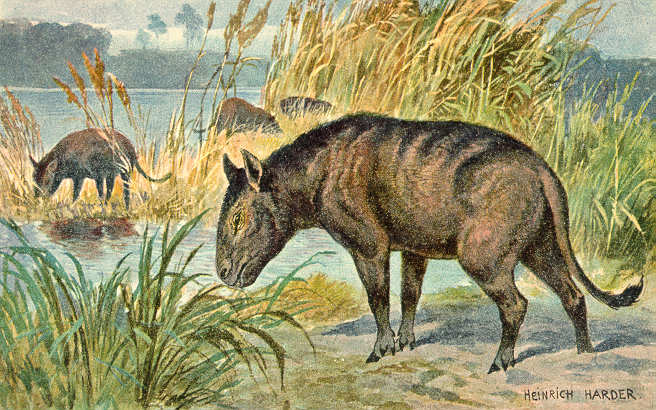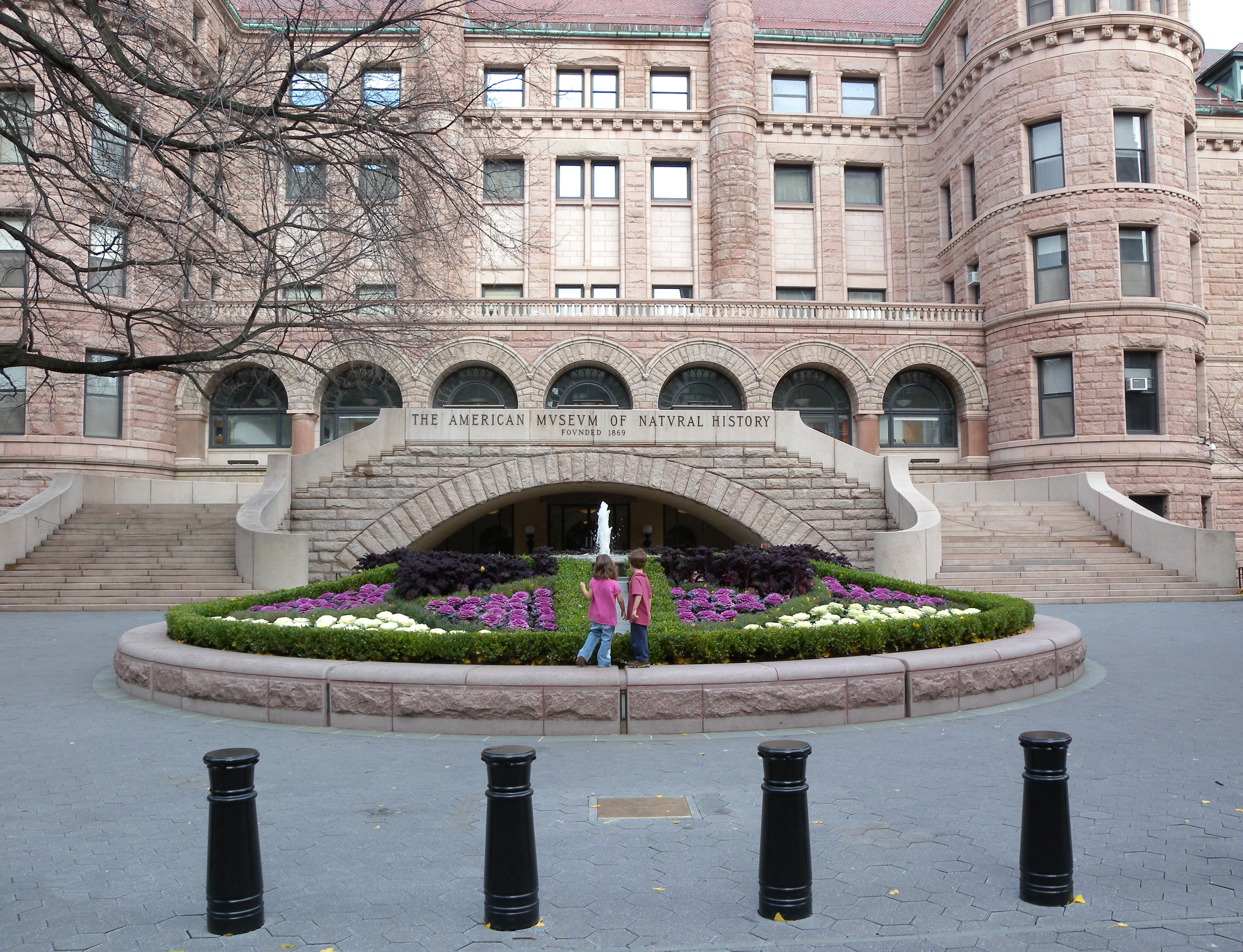|
Oreodon
''Merycoidodon'' (" ruminating teeth") is an extinct genus of herbivorous artiodactyl of the family Merycoidodontidae, more popularly known by the name ''Oreodon'' ("hillock teeth"). It was endemic to North America during the Middle Eocene to Middle Miocene (46—16 mya) existing for approximately . Taxonomy Most researchers in paleobiology and paleontology now use the antecedent genus ''Merycoidodon'' to refer to this Oligocene epoch oreodont, even though it was once widely known by the younger synonym of ''Oreodon''. Taxonomically speaking, ''Merycoidodon'' belongs to the family Merycoidodontidae (once known as "Oreodontidae"), a group of artiodactyls related to camels that were endemic to North America. Its ancestors date back to the Eocene and its last descendants are known from the end of the Miocene, so that oreodonts, broadly speaking, lived throughout most of the Paleogene. Morphology ''Merycoidodon'' would have somewhat resembled a pig in appearance, but had a lo ... [...More Info...] [...Related Items...] OR: [Wikipedia] [Google] [Baidu] |
Merycoidodontidae
Merycoidodontoidea, previously known as "oreodonts" or " ruminating hogs," are an extinct superfamily of prehistoric cud-chewing artiodactyls with short faces and fang-like canine teeth. As their name implies, some of the better known forms were generally hog-like, and the group has traditionally been placed within the Suina (pigs, peccaries and their ancestors), though some recent work suggests they may have been more closely related to camels.Spaulding, M., O'Leary, M.A. & Gatesy, J. (2009): Relationships of Cetacea (Artiodactyla) Among Mammals: Increased Taxon Sampling Alters Interpretations of Key Fossils and Character Evolution. '' PLoS ONE'' no 4(9): e7062.article/ref> "Oreodont" means "mountain teeth," referring to the appearance of the molars. Most oreodonts were sheep-sized, though some genera grew to the size of cattle. They were heavy-bodied, with short four-toed hooves and comparatively long tails. The animals would have looked rather pig- or sheep-like, but featu ... [...More Info...] [...Related Items...] OR: [Wikipedia] [Google] [Baidu] |
Oreodont
Merycoidodontoidea, previously known as "oreodonts" or " ruminating hogs," are an extinct superfamily of prehistoric cud-chewing artiodactyls with short faces and fang-like canine teeth. As their name implies, some of the better known forms were generally hog-like, and the group has traditionally been placed within the Suina (pigs, peccaries and their ancestors), though some recent work suggests they may have been more closely related to camels.Spaulding, M., O'Leary, M.A. & Gatesy, J. (2009): Relationships of Cetacea (Artiodactyla) Among Mammals: Increased Taxon Sampling Alters Interpretations of Key Fossils and Character Evolution. '' PLoS ONE'' no 4(9): e7062.article/ref> "Oreodont" means "mountain teeth," referring to the appearance of the molars. Most oreodonts were sheep-sized, though some genera grew to the size of cattle. They were heavy-bodied, with short four-toed hooves and comparatively long tails. The animals would have looked rather pig- or sheep-like, but fe ... [...More Info...] [...Related Items...] OR: [Wikipedia] [Google] [Baidu] |
Merycoidodon BW
''Merycoidodon'' (" ruminating teeth") is an extinct genus of herbivorous artiodactyl of the family Merycoidodontidae, more popularly known by the name ''Oreodon'' ("hillock teeth"). It was endemic to North America during the Middle Eocene to Middle Miocene (46—16 mya) existing for approximately . Taxonomy Most researchers in paleobiology and paleontology now use the antecedent genus ''Merycoidodon'' to refer to this Oligocene epoch oreodont, even though it was once widely known by the younger synonym of ''Oreodon''. Taxonomically speaking, ''Merycoidodon'' belongs to the family Merycoidodontidae (once known as "Oreodontidae"), a group of artiodactyls related to camels that were endemic to North America. Its ancestors date back to the Eocene and its last descendants are known from the end of the Miocene, so that oreodonts, broadly speaking, lived throughout most of the Paleogene. Morphology ''Merycoidodon'' would have somewhat resembled a pig in appearance, but had a lo ... [...More Info...] [...Related Items...] OR: [Wikipedia] [Google] [Baidu] |
American Museum Of Natural History
The American Museum of Natural History (AMNH) is a natural history museum on the Upper West Side of Manhattan in New York City. Located in Theodore Roosevelt Park, across the street from Central Park, the museum complex comprises 21 interconnected buildings housing 45 permanent exhibition halls, in addition to a planetarium and a library. The museum collections contain about 32 million specimens of plants, animals, fungi, fossils, minerals, rocks, meteorites, human remains, and human cultural artifacts, as well as specialized collections for frozen tissue and genomic and astrophysical data, of which only a small fraction can be displayed at any given time. The museum occupies more than . AMNH has a full-time scientific staff of 225, sponsors over 120 special field expeditions each year, and averages about five million visits annually. The AMNH is a private 501(c)(3) organization. The naturalist Albert S. Bickmore devised the idea for the American Museum of Natural History in 1 ... [...More Info...] [...Related Items...] OR: [Wikipedia] [Google] [Baidu] |
Eocene
The Eocene ( ) is a geological epoch (geology), epoch that lasted from about 56 to 33.9 million years ago (Ma). It is the second epoch of the Paleogene Period (geology), Period in the modern Cenozoic Era (geology), Era. The name ''Eocene'' comes from the Ancient Greek (''Ēṓs'', 'Eos, Dawn') and (''kainós'', "new") and refers to the "dawn" of modern ('new') fauna that appeared during the epoch.See: *Letter from William Whewell to Charles Lyell dated 31 January 1831 in: * From p. 55: "The period next antecedent we shall call Eocene, from ήως, aurora, and χαινος, recens, because the extremely small proportion of living species contained in these strata, indicates what may be considered the first commencement, or ''dawn'', of the existing state of the animate creation." The Eocene spans the time from the end of the Paleocene Epoch to the beginning of the Oligocene Epoch. The start of the Eocene is marked by a brief period in which the concentration of the carbon isoto ... [...More Info...] [...Related Items...] OR: [Wikipedia] [Google] [Baidu] |
Alberta, Canada
Alberta is a Provinces and territories of Canada, province in Canada. It is a part of Western Canada and is one of the three Canadian Prairies, prairie provinces. Alberta is bordered by British Columbia to its west, Saskatchewan to its east, the Northwest Territories to its north, and the U.S. state of Montana to its south. Alberta and Saskatchewan are the only two landlocked Canadian provinces. The eastern part of the province is occupied by the Great Plains, while the western part borders the Rocky Mountains. The province has a predominantly humid continental climate, continental climate, but seasonal temperatures tend to swing rapidly because it is so arid. Those swings are less pronounced in western Alberta because of its occasional Chinook winds. Alberta is the fourth largest province by area, at , and the fourth most populous, with 4,262,635 residents. Alberta's capital is Edmonton; its largest city is Calgary. The two cities are Alberta's largest Census geographic units ... [...More Info...] [...Related Items...] OR: [Wikipedia] [Google] [Baidu] |
Colorado
Colorado is a U.S. state, state in the Western United States. It is one of the Mountain states, sharing the Four Corners region with Arizona, New Mexico, and Utah. It is also bordered by Wyoming to the north, Nebraska to the northeast, Kansas to the east, and Oklahoma to the southeast. Colorado is noted for its landscape of mountains, forests, High Plains (United States), high plains, mesas, canyons, plateaus, rivers, and desert lands. It encompasses most of the Southern Rocky Mountains, as well as the northeastern portion of the Colorado Plateau and the western edge of the Great Plains. Colorado is the List of U.S. states and territories by area, eighth-largest U.S. state by area and the List of U.S. states and territories by population, 21st by population. The United States Census Bureau estimated the population of Colorado to be 5,957,493 as of July 1, 2024, a 3.2% increase from the 2020 United States census. The region has been inhabited by Native Americans in the United St ... [...More Info...] [...Related Items...] OR: [Wikipedia] [Google] [Baidu] |
Zebra
Zebras (, ) (subgenus ''Hippotigris'') are African equines with distinctive black-and-white striped coats. There are three living species: Grévy's zebra (''Equus grevyi''), the plains zebra (''E. quagga''), and the mountain zebra (''E. zebra''). Zebras share the genus '' Equus'' with horses and asses, the three groups being the only living members of the family Equidae. Zebra stripes come in different patterns, unique to each individual. Several theories have been proposed for the function of these patterns, with most evidence supporting them as a deterrent for biting flies. Zebras inhabit eastern and southern Africa and can be found in a variety of habitats such as savannahs, grasslands, woodlands, shrublands, and mountainous areas. Zebras are primarily grazers and can subsist on lower-quality vegetation. They are preyed on mainly by lions, and typically flee when threatened but also bite and kick. Zebra species differ in social behaviour, with plains and mountain z ... [...More Info...] [...Related Items...] OR: [Wikipedia] [Google] [Baidu] |
South Dakota
South Dakota (; Sioux language, Sioux: , ) is a U.S. state, state in the West North Central states, North Central region of the United States. It is also part of the Great Plains. South Dakota is named after the Dakota people, Dakota Sioux tribe, which comprises a large portion of the population—with nine Indian reservation, reservations in the state—and has historically dominated the territory. South Dakota is the List of U.S. states and territories by area, 17th-largest by area, the List of U.S. states and territories by population, fifth-least populous, and the List of U.S. states and territories by population density, fifth-least densely populated of the List of U.S. states, 50 United States. Pierre, South Dakota, Pierre is the List of capitals in the United States, state capital, and Sioux Falls, South Dakota, Sioux Falls, with a population of about 213,900, is South Dakota's List of cities in South Dakota, most populous city. The state is bisected by the Missouri Ri ... [...More Info...] [...Related Items...] OR: [Wikipedia] [Google] [Baidu] |
Territorial Marking
In ethology, territory is the sociographical area that an animal consistently defends against conspecific competition (or, occasionally, against animals of other species) using agonistic behaviors or (less commonly) real physical aggression. Animals that actively defend territories in this way are referred to as being territorial or displaying territorialism. Territoriality is only shown by a minority of species. More commonly, an individual or a group of animals occupies an area that it habitually uses but does not necessarily defend; this is called its home range. The home ranges of different groups of animals often overlap, and in these overlap areas the groups tend to avoid each other rather than seeking to confront and expel each other. Within the home range there may be a ''core area'' that no other individual group uses, but, again, this is as a result of avoidance. Function The ultimate function of animals inhabiting and defending a territory is to increase the indiv ... [...More Info...] [...Related Items...] OR: [Wikipedia] [Google] [Baidu] |
Scent Gland
Scent gland are exocrine glands found in most mammals. They produce semi-viscous secretions which contain pheromones and other semiochemical compounds. These odor-messengers indicate information such as status, territorial marking, mood, and sexual behaviour. The odor may be subliminal—not consciously detectable. Though it is not their primary function, the salivary glands may also function as scent glands in some animals. In even-toed ungulates The even-toed ungulates (Artiodactyla) have many specialized skin glands, the secretions of which are involved in semiochemical communication. These glands include the sudoriferous glands (located on the forehead, between the antlers and eyes), the preorbital glands (extending from the medial canthus of each eye), the nasal glands (located inside the nostrils), the interdigital glands (located between the toes), the preputial gland (located inside the foreskin of the penis), the metatarsal glands (located outside of the hind legs ... [...More Info...] [...Related Items...] OR: [Wikipedia] [Google] [Baidu] |









